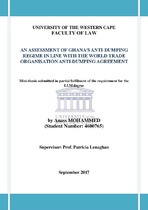| dc.contributor.advisor | Lenaghan, Patricia | |
| dc.contributor.author | Mohammed, Anass | |
| dc.date.accessioned | 2018-09-06T09:19:06Z | |
| dc.date.available | 2018-12-31T22:10:06Z | |
| dc.date.issued | 2017 | |
| dc.identifier.uri | http://hdl.handle.net/11394/6386 | |
| dc.description | Magister Legum - LLM (Mercantile and Labour Law) | |
| dc.description.abstract | The establishment of an anti-dumping regime has become commonplace for many a
government that seeks to protect and promote its local industries. One reason which appears to
be dominant by its proponents is the need to curb predatory pricing. Another reason given by
the proponents of anti-dumping is the need to maintain a level playing field for players in any
particular industry. With these reasons and probably many others, anti-dumping legislation
began to find its way into present-day trade.
Canada, with its anti-dumping statute of 1904 [An Act to Amend the Customs Tariff 1897, 4
Edw VIII, 1 Canada Statutes 111 (1904)] is credited with the first modern anti-dumping
legislation. New Zealand followed in 1905 with the Agricultural Implement Manufacture,
Importation and Sale Act 1905, which was primarily meant to protect New Zealand's
manufacturers of agricultural implements. The Industries Preservation Act 1906 which
Australia enacted was to deal with market monopoly by manufacturers but it also contained
provisions on anti-dumping. The first decade of the 20th century will thus qualify to be called
the introductory decade of anti-dumping legislation. | |
| dc.language.iso | en | |
| dc.publisher | University of the Western Cape | |
| dc.subject | ADA Compliance, Anti-dumping, Dumping, Ghana, Ghana Trade Policy, Ghana International Trade Commission, Tariff Advisory Board, Trade Remedies | |
| dc.title | An assessment of Ghana's anti-dumping regime in line with the World Trade Organisation Anti-Dumping Agreement | |
| dc.rights.holder | University of the Western Cape | |

